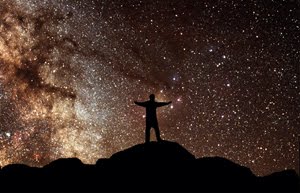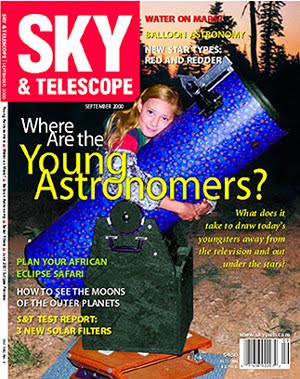Friday afternoon I drove to Lick Observatory to volunteer as a docent at the Music of the Spheres program. I had been looking forward to the evening, as the scheduled performance was by Andean flute master Oscar Reynolds, and a lecture by Geoff Marcy of extra-solar planet fame. The only drawback was a 77 percent moon, which would obliterate all but the brightest of deep sky targets. However, there was also the promise of observing from 4200 feet elevation in what are regularly very steady skies... after the public left, and after moonset.... so all in all, the plan was a winner.
The drive up was beautiful, as usual. About one hour of attentive but relaxing cruising, past great mountain views, past lakes, quail running across the roads, old twisted oaks, grazing cattle, all the while with the domes atop the peak getting progressively larger... then suddenly the turn toward the offices and domes of the 36" Clark refractor and 40" Nickel Ritchey-Chretien. I was the first of the group to arrive. Marek Cichanski, Jeff Crilly and Sandra Macika would arrive to round out the crew of telescope volunteers.
As the concert began, the sound of the flute, really Andean pipes, took me back to the sounds of street performers in La Serena Chile, an astronomy trip from 2005.
As the concert was taking place, the night's speaker came by and spent time looking through Marek's telescope, interested in particular in the spectrographic eyepiece showing emission and absorption lines of various stars. The observatory draws top notch speakers. I've enjoyed listening to Alex Fillipenko at Lick as well.
Bottom line, volunteering as a docent at Lick has lots of benefits!
I was looking through Jeff's 12" Meade Advanced RC, at the moon. While I enjoyed some of the detail in Clavius and Plato, I noted the slow rolling effect the atmosphere was giving. The view looked as if it were through a slow stream of water. Not terrible seeing, but it would make splitting tight doubles more of a challenge.
After the public left I began observing in Cepheus, and spent much of the night there, then in Cygnus and finally Andromeda. The first target was Pi Cepheus, a mag 4.4 1.2 arc second double in an easy location near the pointed top of the constellation. While easy to get, this one would not split with the 7 Nagler and 2X barlow, due to unsteadiness.
Before more on what I observed, there were several double stars on my list, and really few challenging deep sky targets, due to the moon phase and proximity of lights from San Jose, but I did include a few.
Struve 2923 is SAO 20150, an easy double to split at mags 6.3 and 9.5, a nice difference. They sit 9.5" apart with a yellow primary west of its red secondary. This double is found is an easy hop within the "hat" of Cepheus.
I moved to Struve 2883, SAO 19922 is a naked eye target at mag 5.5, just west of the prior target, and slightly wider with an almost opposite position angle It is a yellow primary with nearly yellow companion to its southwest.
Six and a half degrees east southeast, outside the "hat" in Cepheus is Omricon, a double with separation of 3.1" and mags 4.9 and 71. Nice double, good split with 12 Nagler. Both yellow, primary is to northeast of secondary.
Struve 457 is very easy to locate, just off the bright star in the center of the box of Cepheus. Its very tight with 7 Nagler. Yellow/white primary with almost violet secondary to its west. This is SAO 20554, mags 5.0 and 7.6 with a separation of 1.3'.
Next object was Abell 75, or NGC 7076, which I decided to skip, thinking this sky was too bright. I continued on the doubles.
Stuve 2950 is SAO 20281. I had no split with 7 Nagler. Or possible very tight split, equal colors and mags - maybe hint of a north south orientation, ruddy color. Mags 6.1 and 7.4 with a 1.4" separation.
Before continuing, I'll go back to the public part of the night. The music was excellent. I could stand in the patio behind the main building, look through the glass doors to the back of the stage, see the audience to the left, right and in front. Oscar is an excellent performer, on guitar, singing, and playing flute. Once the performance ended, he came out back with his small young son, and both looked through my 18" Dob. The little boy was looking at Epsilon Lyra, and describing it. The entire musical group looked. Had a great time with them.
As the other guests waited to view through the 36", they came out back and looked through our scopes. I mostly showed Epsilon Lyra, the Blinking Planetary (people love it when this object blinks!), M13, M3 and the Veil. Others were showing the moon, M57 and spectra of stars. It was a bright night.
Back to what I observed after the public left...
15 Cepheus is SAO 34016, and is part of a nice chain of four stars in a line. At mag 6.7 and 11.4 its separation is 11.1", it was an easy split with my 12 Nagler. The primary is off white, secondary is blue/green.
Struve 440 is easy in 12mm, primary is gold, secondary is green and to south. Nice double. Mags 6.4 and 10.7, separation of 11.4", SAO 33443. It is an easy hop from Alpha Cephei.
A short hop south southwest is Struve 2790, an excellent double due to the primary's redness. Secondary is blue, dim, and close to north east. SAO 33443, mags 5.7 and 10.0, separation 3.4".
One of my favorite multiple stars in Struve 2816, close to Mu Cephei. It has a yellow primary flanked by two white/blue companions of equal mag. Its SAO number is 33626. What puzzled me was another double, that had the shared Struve 2816's location, Burnham 1143. Perhaps the dim secondary, mag 13.3, is too dim to pick out on a breezy night, with a tighter 1.6" separation.
That turned out to be the last double of the night. It was now past two, the moon was gone, and the next object was Abell 77, a planetary I was not going to attempt. But I changed my mind. Its located in an easy spot, Mu Cephei to Struve 2816 and beyond, just before SAO 33458. I was very surprised to see it. I observed a definite smallish gray round glow using an OIII in 12 nagler. After this, I felt encouraged to return to Abell 75.
Abell 75, or NGC 7076, is at a very easy location, almost exactly a degree east of Alpha Cephei. I could see it without a filter. Putting the OIII filter in on the 12 Nagler made it easy to see, roundish, annular,brighter on N edge. Larger than Abell 77.
I then went an a short open cluster spree. It is amazing the variety open clusters come in. I think they are more diverse than galaxies or planetaries. Some are very easy, others are extremely tough.
The first was NGC 7086 in the far northern reaches of Cygnus. Very easy to identify, bright, large, perhaps 8x8, about 8 bright stars, a dozen dimmer, then many dim stars, somewhat heart shaped. Stands out from field.
Next was an open cluster not on my target list. Turns out, a red star, BD +48 4070, or SAO 53088 is embedded in NGC 7686. Red, bright, yellow/orange actually, offset in eastern portion of the cluster which has many bright stars - it seems sparse, but has many dim members in western portion.
I was off to the one piece of eye candy on my list, M39. Its an easy location. Actually, it showed up well in my 10x70 finder, I could see the individual stars in the cluster. It is a beautiful bright coarse sparse open cluster filling up to 48 arc minutes of the field in my 20 Nagler. I'm sure I've used the term before, but this has a poor man's Beehive feel to it. The number of bright stars is great!
I used stars in M39 to star hop to the dim cluster NGC 7067, which is part of the Herschel 400-II list. My notes describe it as difficult, small, seven or eight brighter stars over oval sprinkle of many dim stars elongated east/west. Showed better in 12 than 20 Nagler. This is frost on a window in winter.
The last object of the night was open cluster NGC 7082, also on the Herschel 400-II. This cluster formed a nice equilateral triangle with M39 and NGC 7067, so it too was easy to find. This entire area is rich in open clusters. NGC 7082 is a large sparse cluster mixed in with into Milky Way fields to its north and south. Large number of dim background stars interspersed with a handful of brighter members helps define it.
By now it was almost 4:30 in the morning. I was licked. This is the latest I'd observed in a long time. Marek and Jeff remained as I crawled into my truck for a short rest. After an hour I was back out, sunrise glowing warmly over the dome of the Shane 120 to our east. Jeff packed up as did I, and we headed down the mountain. It had been a surprisingly good night.
Next observing will be Houge Park in a few weeks, then off to Willow Springs for new moon. Already looking forward to it.











